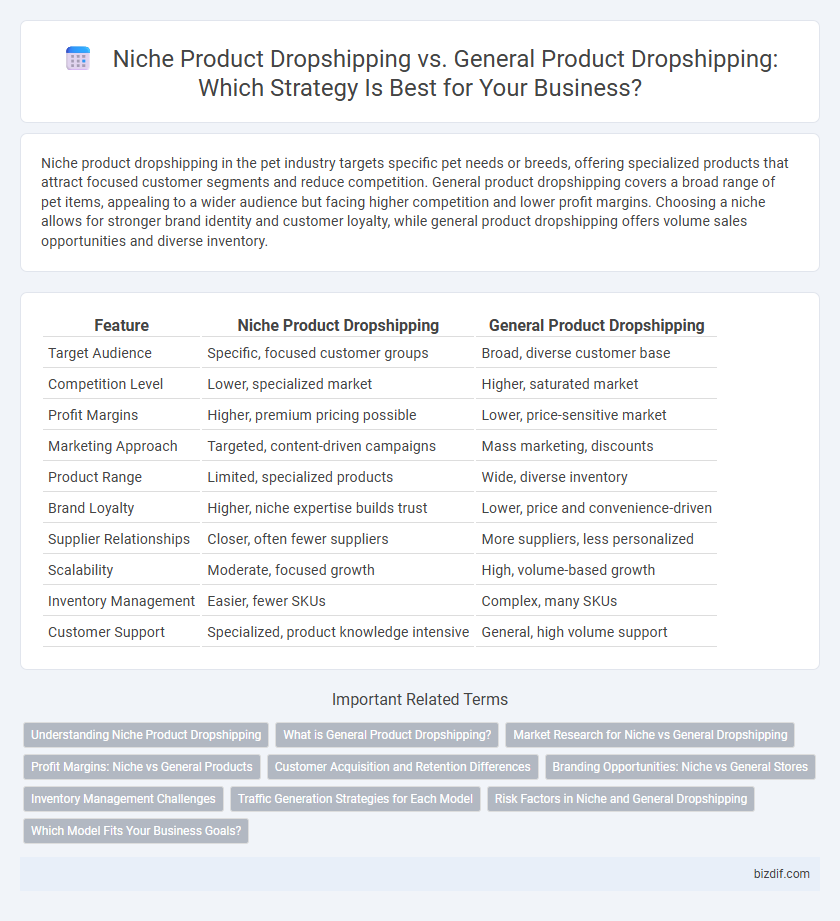Niche product dropshipping in the pet industry targets specific pet needs or breeds, offering specialized products that attract focused customer segments and reduce competition. General product dropshipping covers a broad range of pet items, appealing to a wider audience but facing higher competition and lower profit margins. Choosing a niche allows for stronger brand identity and customer loyalty, while general product dropshipping offers volume sales opportunities and diverse inventory.
Table of Comparison
| Feature | Niche Product Dropshipping | General Product Dropshipping |
|---|---|---|
| Target Audience | Specific, focused customer groups | Broad, diverse customer base |
| Competition Level | Lower, specialized market | Higher, saturated market |
| Profit Margins | Higher, premium pricing possible | Lower, price-sensitive market |
| Marketing Approach | Targeted, content-driven campaigns | Mass marketing, discounts |
| Product Range | Limited, specialized products | Wide, diverse inventory |
| Brand Loyalty | Higher, niche expertise builds trust | Lower, price and convenience-driven |
| Supplier Relationships | Closer, often fewer suppliers | More suppliers, less personalized |
| Scalability | Moderate, focused growth | High, volume-based growth |
| Inventory Management | Easier, fewer SKUs | Complex, many SKUs |
| Customer Support | Specialized, product knowledge intensive | General, high volume support |
Understanding Niche Product Dropshipping
Niche product dropshipping targets a specific segment of the market by offering specialized products that cater to distinct customer needs or interests, enhancing brand loyalty and reducing competition. This approach allows dropshippers to optimize marketing strategies and improve conversion rates by addressing a well-defined audience with tailored messaging. Unlike general product dropshipping, focusing on niche products enables better inventory management and often results in higher profit margins.
What is General Product Dropshipping?
General product dropshipping involves selling a wide range of diverse items without focusing on a specific niche, allowing sellers to target a broader audience and capitalize on trending products across multiple categories. This approach often requires managing extensive inventory options and competitive pricing strategies to attract various customer segments. Sellers using general product dropshipping benefit from flexibility but face challenges in brand differentiation and specialized marketing.
Market Research for Niche vs General Dropshipping
Market research for niche product dropshipping requires in-depth analysis of specific customer segments and targeted keywords to identify specialized demand and reduce competition. General product dropshipping relies on broader market trends and high-volume keyword data to capture widespread consumer interest but faces intense competition and lower profit margins. Effective market research tools like Google Trends, SEMrush, and competitor analysis are crucial for both models to optimize product selection and marketing strategies.
Profit Margins: Niche vs General Products
Niche product dropshipping typically offers higher profit margins due to less competition and the ability to target specific customer segments willing to pay premium prices. General product dropshipping often results in lower profit margins because of intense market saturation and price wars among sellers. Focusing on niche products enables dropshippers to command better pricing, improve customer loyalty, and reduce advertising costs.
Customer Acquisition and Retention Differences
Niche product dropshipping targets specific customer segments with specialized products, leading to higher customer acquisition efficiency and stronger brand loyalty due to personalized marketing and curated offerings. General product dropshipping casts a wider net, attracting a broad audience but facing higher customer acquisition costs and lower retention rates because of less focused product selection and increased competition. Focusing on niche markets enhances customer lifetime value through tailored experiences, whereas general product strategies rely on volume and frequent promotions to maintain customer engagement.
Branding Opportunities: Niche vs General Stores
Niche product dropshipping offers superior branding opportunities by allowing stores to target specific customer segments with tailored marketing, creating a strong and recognizable brand identity. General product dropshipping struggles with brand differentiation due to its wide product range and less focused audience, making it harder to build customer loyalty. Specialized branding strategies are more effective in niche stores, leading to higher conversion rates and customer retention.
Inventory Management Challenges
Niche product dropshipping presents inventory management challenges due to limited supplier options and potential backorder risks, requiring precise stock tracking and demand forecasting. General product dropshipping offers broader supplier networks but increases complexity in managing diverse SKUs and varying inventory turnover rates. Efficient inventory synchronization systems are critical for both models to prevent stockouts and maintain customer satisfaction.
Traffic Generation Strategies for Each Model
Niche product dropshipping relies heavily on targeted SEO and social media campaigns tailored to specific customer interests, driving highly qualified traffic through content marketing and influencer partnerships focused on unique product categories. General product dropshipping emphasizes broad-spectrum traffic strategies including paid advertising, extensive PPC campaigns, and marketplace optimization to attract diverse audiences and maximize reach across multiple product types. Leveraging data analytics to refine customer segmentation helps both models optimize ad spend and conversion rates by aligning promotional efforts with user search intent and buying behaviors.
Risk Factors in Niche and General Dropshipping
Niche product dropshipping carries higher risk due to limited market demand and reliance on specific customer segments, increasing vulnerability to demand fluctuations and supplier issues. General product dropshipping offers broader market appeal and diversifies risk but faces intense competition and lower profit margins. Balancing these factors is crucial for sustainable dropshipping success and effective inventory management.
Which Model Fits Your Business Goals?
Niche product dropshipping targets a specific market segment, allowing for tailored marketing strategies and higher customer loyalty, making it ideal for businesses aiming for brand authority and specialized customer engagement. General product dropshipping offers a broader inventory, attracting diverse customers and enabling faster scaling, which suits businesses focused on volume sales and market diversification. Choosing the right model depends on whether your priority is niche expertise with focused growth or wide-range product availability for rapid expansion.
Niche Product Dropshipping vs General Product Dropshipping Infographic

 bizdif.com
bizdif.com